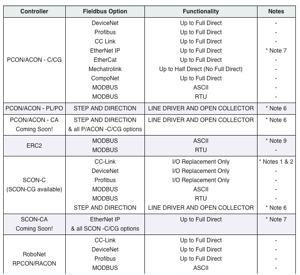|
||
| Container Sealing Application Example | ||
|
|
||
| Actuator |
RCP2-GRHM
|
|
|
Controller
|
PCON |
|
|
||
All posts by IAI America
IAI Product Fieldbus Compatibility Matrix
A Fieldbus Compatibility Matrix has been posted to IAI America’s website.
Please click IAI Fieldbus Compatibility to view the matrix.

8-axis ROBO Cylinder Electric Shaft Coin Demo Video
This display unit uses the electronic shaft function of the XSEL controller to operate one master axis and seven slave axes in an interlocked pattern.
The eight rod cylinders are moved simultaneously under synchronization control to move sheet-shaped work parts up and down.
Since synchronized commands are issued via pulse train control to the controller that controls each actuator, the sheet-shaped work parts do not tilt and a coin balanced on the work parts remain stationary without tipping.
This function is useful in situations where sheet-shaped work parts such as glass substrates are transferred up and down.
Anti-Vibration Function Demo Video
This display unit uses the vibration damping control function of the XSEL controller to show you a visual comparison of the condition of vibration in normal movement and where vibration is suppressed by vibration damping control.
This function suppresses vibration of the actuator as well as vibration of the work part installed on the actuator.
Without vibration damping control, vibration increases and therefore the actuator must spend extra time to wait until the vibration stops.
With the vibration damping control function, the end of the work part is almost still because vibration is suppressed. This results in a shorter wait time and cycle time.
This function is also effective in situations when the mechanical rigidity of the system must be increased to suppress vibration.
Note that this function can suppress vibration in a frequency range of 0.5 Hz to 30 Hz.
